Economic Trucking Trends: Good news galore can be found in recent data
It’s a good news edition of our weekly economic trucking trends report. Truck tonnage spiked in February, trucking conditions improved slightly, February trailer orders were strong, and both rates and volumes inched upward in the spot market.
In its monthly economic report, Motive predicted an increasingly carrier-friendly environment as we work through the year. Let’s dive into it…
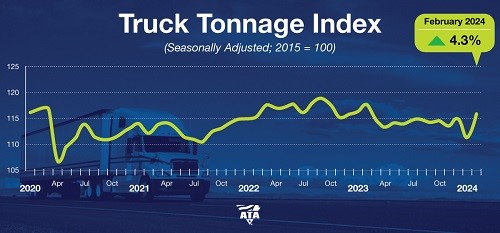
Truck tonnage snapped back in February
U.S. for-hire truck tonnage spiked 4.3% in February, according to the latest data from the American Trucking Associations (ATA). This after falling 3.2% in January.
“After a very soft January, due in part to winter storms, truck tonnage snapped back in February,” said ATA chief economist Bob Costello. “February’s level was the highest in a year, yet the index still contracted from a year earlier, suggesting truck freight remains in a recession.”
The index was 1.4% off year-ago levels, marking the 12th straight year over year decline.
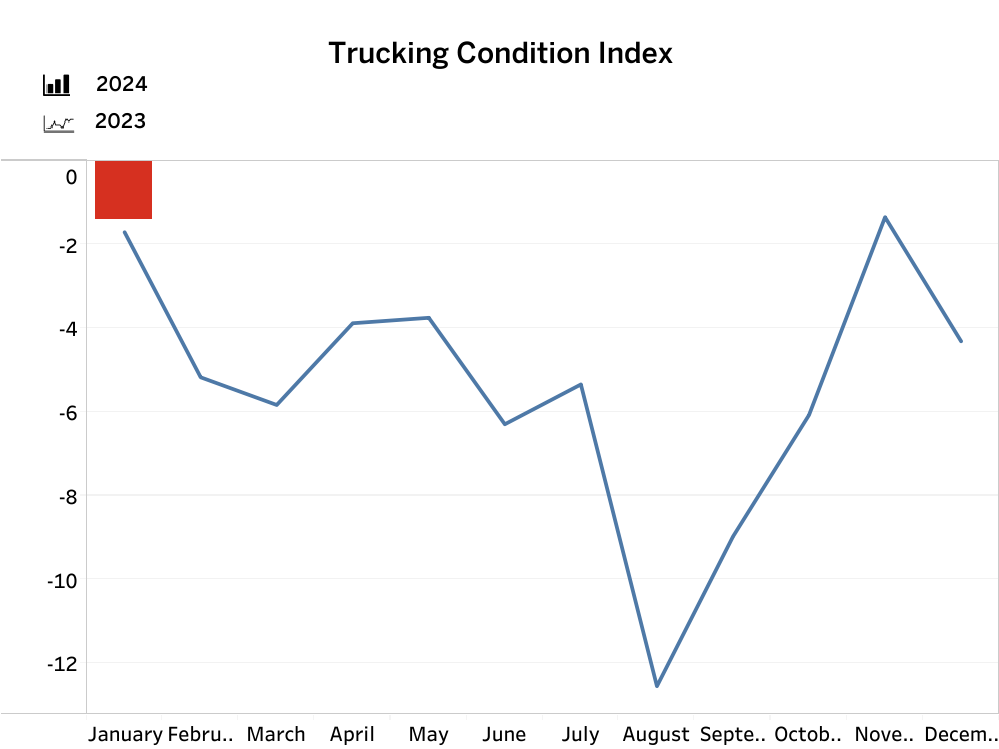
Trucking conditions improve
Trucking conditions improved in January, climbing from a negative reading of -4.3 in December to a less-negative -1.41. Freight rates and financing costs improved for carriers, according to FTR, which tracks its Trucking Conditions Index.
Fuel costs were less favorable on the month. FTR said conditions are improving for truckers, but it expects them to remain in negative territory for most of this year.
“Our forecast for freight volume is modestly stronger, but excess capacity continues to temper our expectations for a market revival,” said Avery Vise, FTR’s vice-president of trucking.
“Absent a triggering event like a surge in fuel prices, for example, we see a continued gradual drain of capacity that will not begin to shift market fundamentals for months. The eventual rebound also might be uneven as the first signs of improvement could slow the exit of excess capacity and delay a sustained recovery.”
Trailer orders surge
Trailer orders surged 37% in February, with 21,331 units ordered according to preliminary data from FTR. That was 9% above the average of the previous 12 months, but down 18% from February 2023.
Production jumped 22%, putting a small dent in backlogs.
“The increase in production, coupled with the fall in backlogs, resulted in some downward change to the backlog-to-build ratio, which stands at 5.7 months,” said Eric Starks, FTR’s chairman of the board.
“This ratio is right in line with the average level for the last half of 2023 and is slightly below the historical average prior to 2020. A fall in the ratio is normal following the holiday season, and the overall picture is still that of an industry that is continuing its move towards stability.”
ACT Research reported orders of 20,500 units, down 21% year over year by its count.
“Against year-ago data still impacted by pent-up demand that is now gone, softer order intake activity continues to meet expectations,” said Jennifer McNealy, director, commercial vehicle market research and publications at ACT Research.
“Net orders remain challenged by a backdrop of weak profitability for for-hire truckers. Anecdotal commentary from trailer manufacturers and suppliers through the past several months have indicated this slowing, as they have shared that orders are coming, but at a more tepid pace when compared to the last few years.”
She added, “This month’s results continue to support our thesis that when fleets don’t make money, their ability and/or willingness to purchase equipment is muted. That said, the lower orders now don’t indicate a catastrophic year in the offing, as the economy continues to expand at an above-trend rate in Q1, and goods-producing economic sectors that were out of favor last year are looking healthier in 2024.”
Private fleets driving new Class 8 demand
Meanwhile, ACT Research reported in its State of the Industry: NA Classes 5-8 report, that private fleets continue to be the primary drivers of Class 8 orders.
Its final tally of February orders totaled 27,745 units, up 16% year over year.
“Given ongoing weak for-hire economics, we believe private fleet capacity additions continue as the driver of U.S. tractor orders above replacement levels,” said Kenny Vieth, ACT’s president and senior analyst.
In a related announcement, Vieth said private fleets – with their longer trade cycles – are pulling forward Class 8 truck orders to get ahead of a widely anticipated pre-buy ahead of EPA27 emissions rules.
“Private fleets’ longer trade cycles are supportive of more aggressive capacity planning three years ahead of the EPA’s 2027 Clean Truck mandate,” said Vieth. “The strength in private fleet demand and expansion is fueled by both strong corporate profits and pandemic-era for-hire capacity constraints. Private fleet capacity additions were a major story in 2023 that appears set to continue through 2024.”
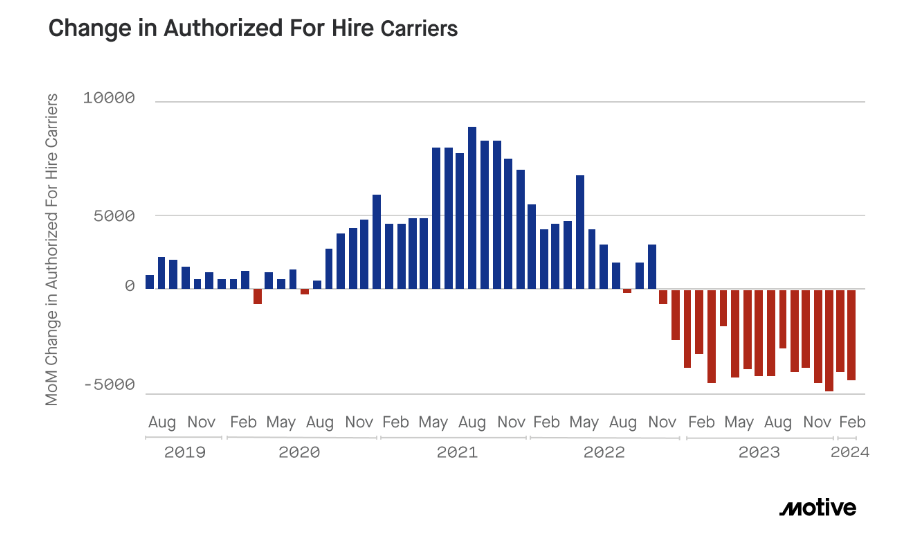
More ‘carrier-friendly’ environment looms: Motive
Motive reported in its monthly economic report that February saw a 9% jump in new carrier registrations in the U.S., totaling 8,675, while 4,000 carriers left – a 10.3% jump from January.
It reported that the increase in registrations indicates a “cautious optimism,” with Motive anticipating rates will continue to push upward through the year.
Motive noted a 1.2% increase in commercial vehicle visits to the Top 50 retailers from the previous month, while diesel prices reversed their decline and climbed 3.1%.
The company reported in the second half of this year, “We will be in a more carrier-friendly environment.”
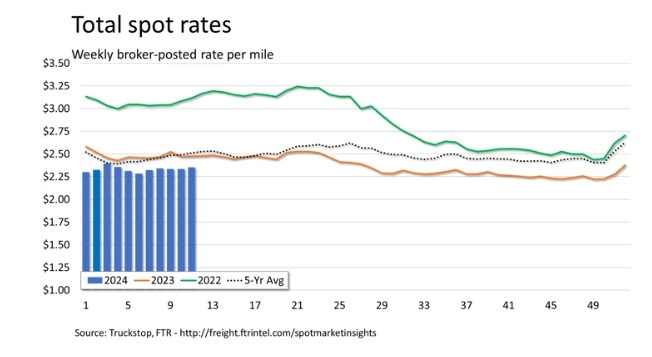
Spot market rates and volumes rise
Truckstop and FTR Transportation Intelligence had good news to report for spot market truckers for the week ended March 15. Both rates and volumes increased, with rates rising across all equipment types for the first time since mid-January, when winter storms drove up demand.
Refrigerated rates shook off recent declines in a possible pre-Easter show of strength. Dry van rates went up for the second time in three weeks, but the decrease in that period was twice as large as the combined increase in the other two weeks. Flatbed continued to be strong, with rates rising for the fourth time in the past five weeks, and in all but three weeks this year.
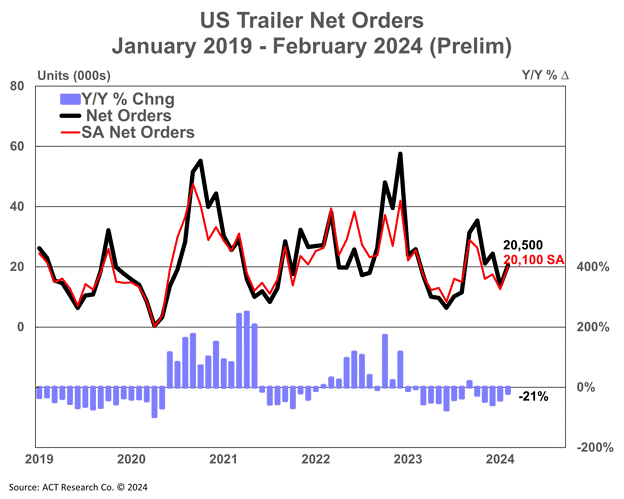
Have your say
This is a moderated forum. Comments will no longer be published unless they are accompanied by a first and last name and a verifiable email address. (Today's Trucking will not publish or share the email address.) Profane language and content deemed to be libelous, racist, or threatening in nature will not be published under any circumstances.